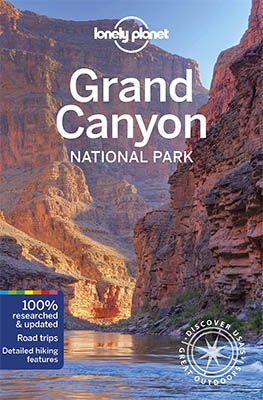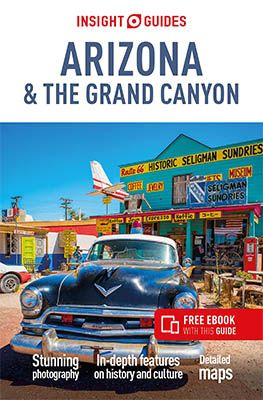The grandiose Grand Canyon National Park
The grandiose Grand Canyon National Park
The iconic Grand Canyon National Park had long been on our bucket list. We thought the huge gorge carved by the Colorado River over millions of years looked impressive in photos. Yet we heard from other travellers that you actually have to see the Grand Canyon for yourself to believe it. Having been there in late September, we can wholeheartedly agree. One thing is certain: you can never get bored of the breathtaking panoramas and landscapes of this seventh wonder of the world!
Besides, there is more to do than just marvel at the average mile-deep ravine. For instance, there are numerous beautiful hiking trails, both short and long. You can also cycle, ride a donkey, or view the gorge from a helicopter or plane. And if you stay in the park, you can experience the most beautiful sunrises and sunsets.
In this blog, we’ll give some tips on what not to miss in the Grand Canyon National Park. We’ll conclude with many practical things for your visit to the park. But we’ll start with some general information about this unique UNESCO World Heritage Site.
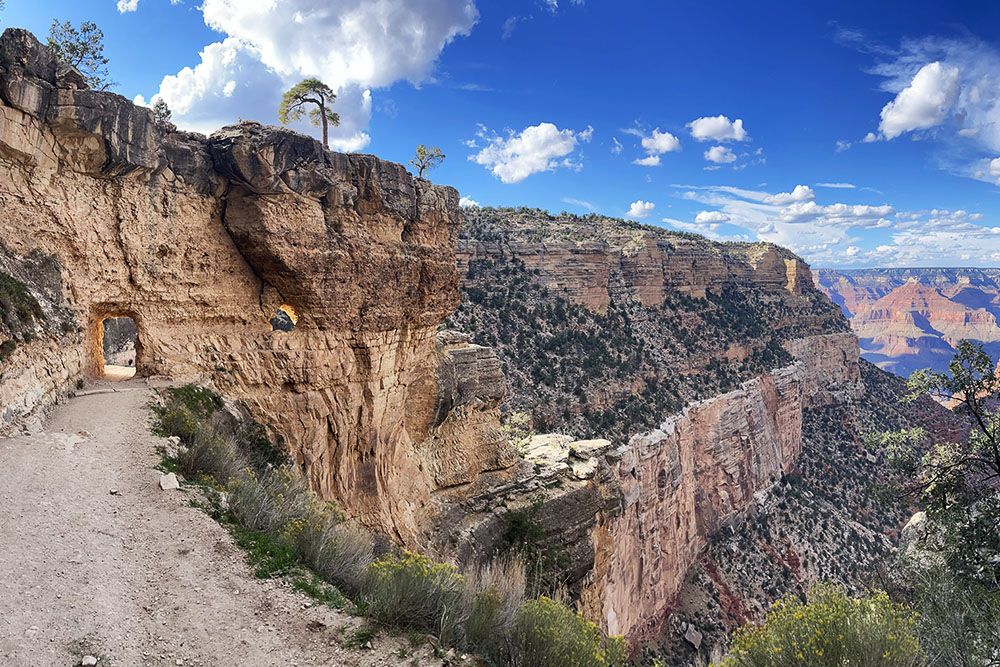
The Grand Canyon National Park
The Grand Canyon was formed 5 to 6 million years ago when the Colorado River made its way through the rocky plateau. The area has been inhabited since the last ice age. For the past 800-plus years, the canyon has been the home of the Havasupai. The first pioneers of European descent settled near the south rim of the Grand Canyon in the late 19th century. They were there in search of gold and copper but found that money could be gotten faster through tourism.
After a railway line was built to the south rim of the canyon, tourism boomed. President Roosevelt also visited the area at that time. He was so impressed by the landscape that he made parts of the Grand Canyon a reservation and later a National Monument in the early 20th century. The national park was then established in 1919 and has since expanded to include several other national monuments. The park now covers an area of almost 2,000 square miles, almost the same size as the entire county of Durham.
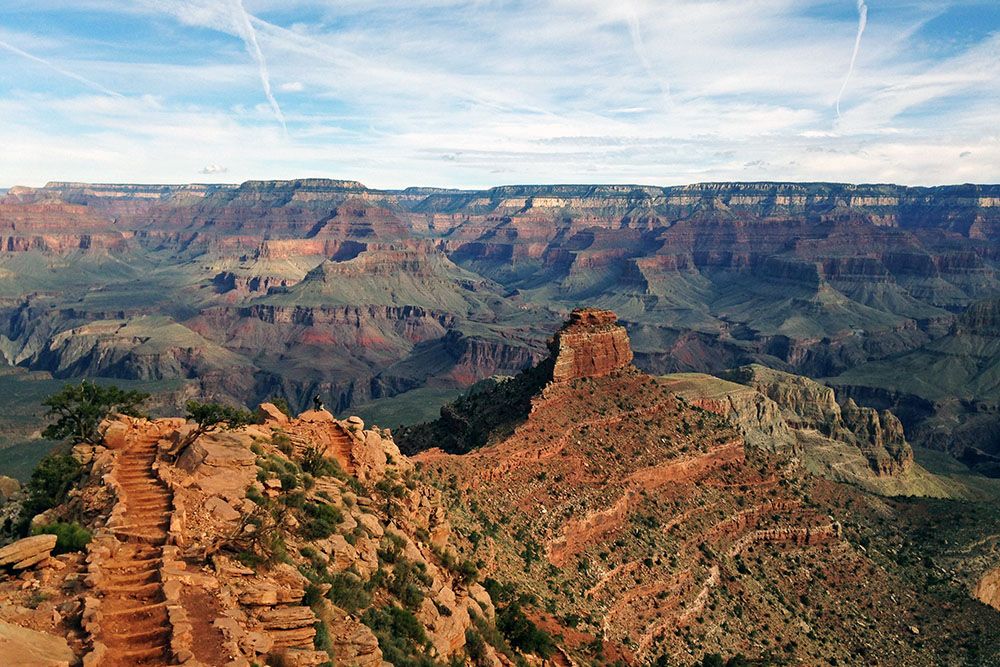
What to see and do in Grand Canyon National Park
You can admire the Grand Canyon from both the North Rim and the South Rim. The part on the South Rim is the most accessible and popular part of the Grand Canyon National Park. You also have the most facilities here.
The part on the North Rim is 900 feet higher. You have a bit more precipitation and lower temperatures there than at the South Rim. In addition, this part of the park is a lot harder to reach. Still, the North Rim is definitely worth a visit. This is because it is even more photogenic, even more forested and pleasantly quiet.
Whatever part of the Grand Canyon National Park you want to visit, you will find countless viewpoints. You’ll need a whole day to see them all. This applies to both the South Rim and the North Rim. You can do some fantastic hiking trails at and near most of the viewpoints.
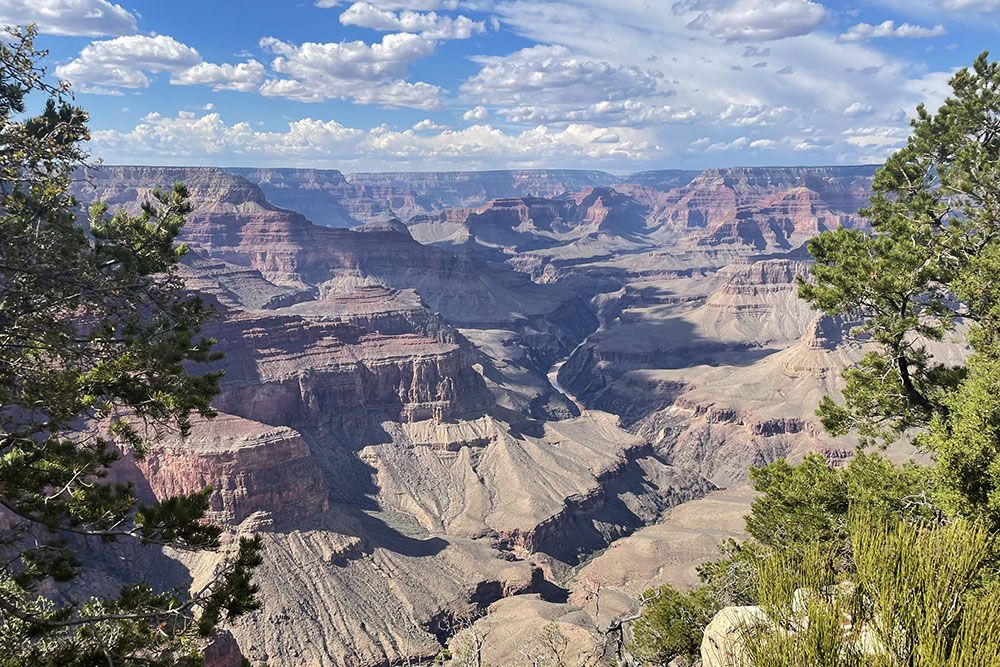
What to do at the South Rim of the Grand Canyon
Start your visit to this southern part of the park at the visitor centre. Here you’ll find lots of information about the park (geology, flora, fauna) and about the hikes you can take. Signs even indicate the best things to see and do if you only have one day in the park. And what not to miss if you have more than one day to spend. You can also fill your water bottles with pure spring water here. Given the heat and plenty of sunshine, this is definitely not an unnecessary luxury!
Rim Trail
Right along the precipice, a hiking trail runs from South Kaibab just east of the visitor centre, to Hermits Rest in the west. The excellent trail is mostly paved, but to the west you also have sections that are unpaved. The trail is 12.8 miles in total. The great thing, however, is that you can skip parts by taking the free shuttle from time to time. In fact, this shuttle stops at every official viewpoint. The Rim Trail is the most ideal way to immediately enjoy the most stunning views. And the great thing is: they are all (totally) different.
Have a shuttle drop you off at Yaki Point and then hike back to the visitor centre via South Kaibab. From there, walk on to the starting point of the Bright Angel Trail, or take a shuttle in that direction. Hermits Rest you can then reach – either partly walking or not – with another shuttle.
By the way, if you stay in the park, go to Hopi Point viewpoint for the best sunrise you’ve ever seen.
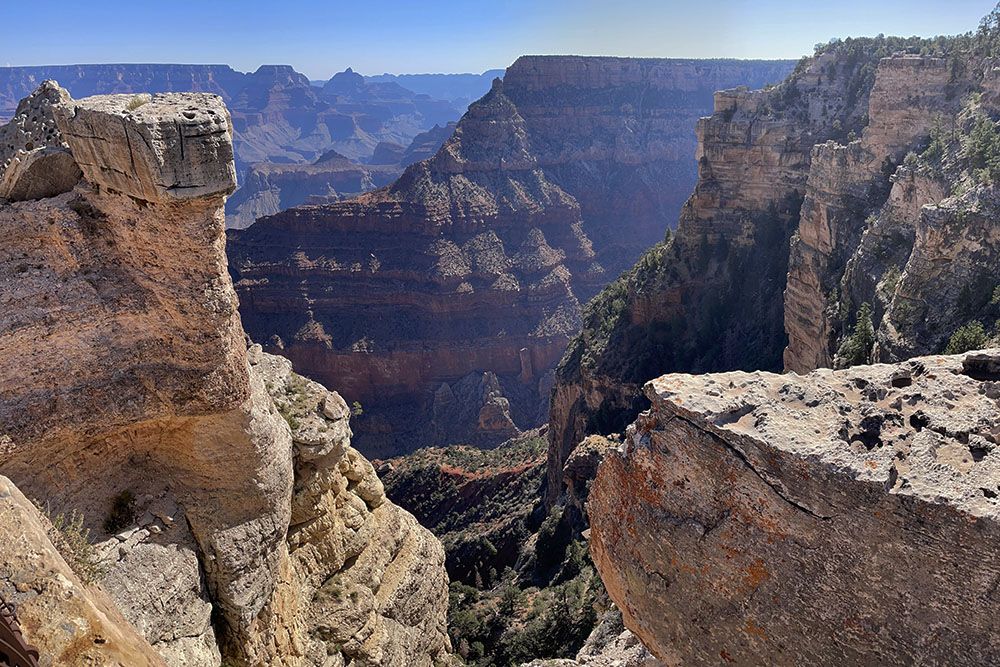
Desert View
If you still have time, be sure to visit Desert View: a rather unique viewpoint overlooking the Colorado River that curves from south to west. High on the edge of the cliff, you’ll find a 70-feet-high, 1932 stone watchtower here. For great views, head to the top floor.
Desert View is the last of the official viewpoints east of the visitor centre. It is especially the beautiful Desert View Drive to it why you should not miss this viewpoint. The car route starts near the South Kaibab Trail and then winds 23 miles further along the gorge to the east. Along the way, you’ll pass viewpoints like Duck on a Rock, Grandview Point and Navajo Point.
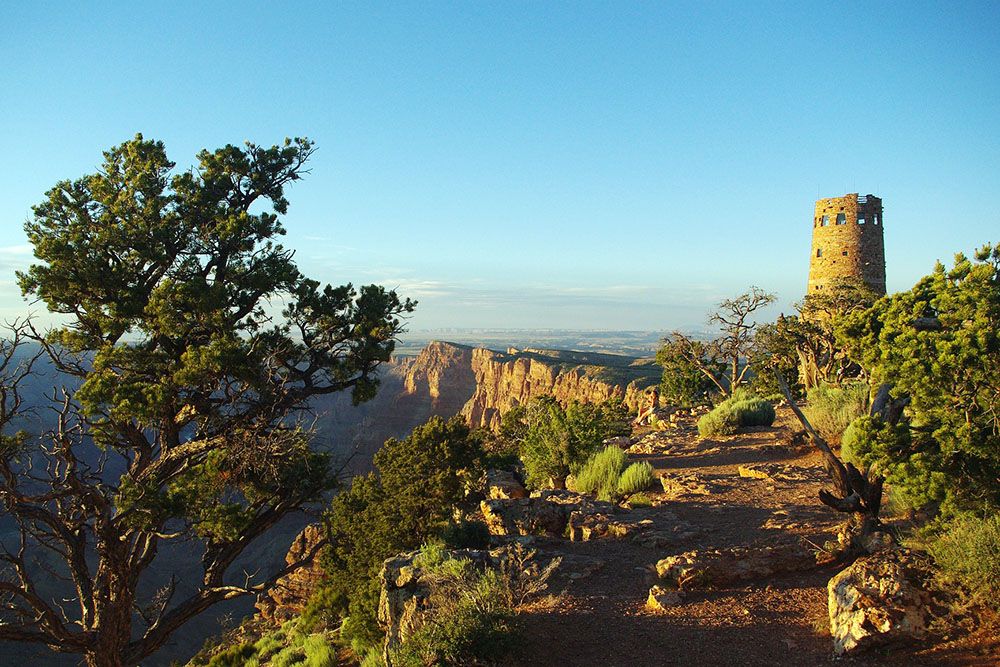
Highlights at the North Rim of the Grand Canyon
Our advice to visit the visitor centre first also applies to the North Rim. Here you will get the most up-to-date information on routes but also on any closures in the park (due to weather). Furthermore, you have some interesting exhibits about the Grand Canyon there.
Cape Royal Scenic Road
According to many, the best views of the Grand Canyon are on the North Rim. The best viewpoints on the North Rim are almost all along the Cape Royal Scenic Road. This motorway is 23 miles long in total. If you didn’t stop anywhere, it would only take 45 minutes. But with viewpoints such as Point Imperial, Vista Encantada, Roosevelt Point, Valhalla Overlook and Cape Royal, you should really count on needing a day.
Our favourite is Cape Royal, the last viewpoint on the Scenic Road. You reach the grandiose viewpoint via an easy mile’s walk downhill. On the route, you also get to see Angel’s Windows. There short path takes you from the main trail to the best location to look through the angel’s window. But for the best sunrise, you absolutely must be at viewpoint Point Imperial. At almost 9,000 feet, this is the highest viewpoint. You’ll get a very different view from the other two vantage points mentioned earlier.
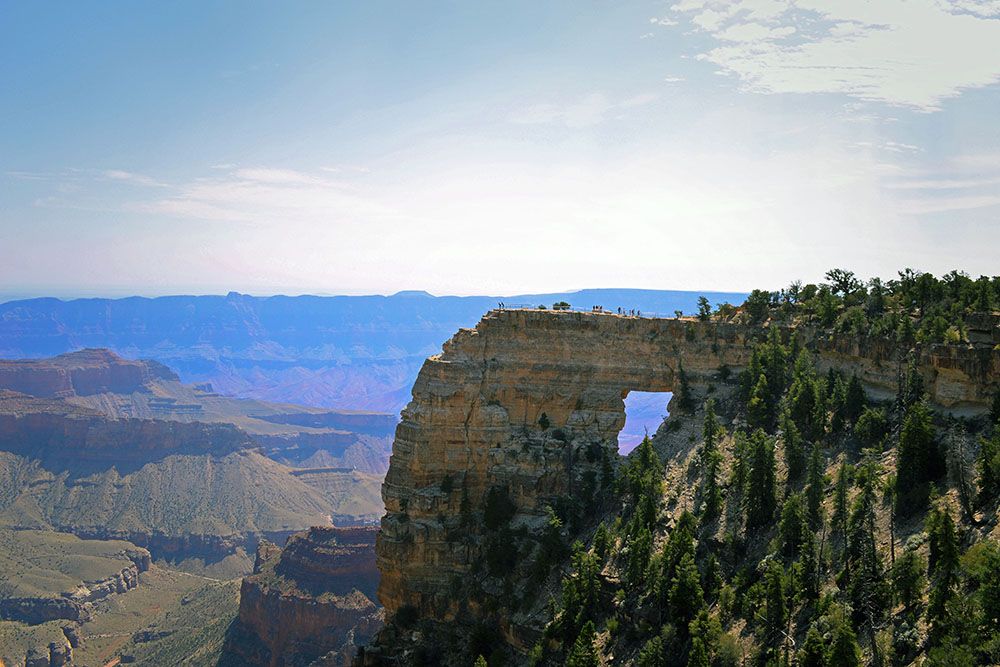
Into the canyon
You can spend several days hiking the many beautiful trails at the top of the canyon. But for the real, avid hiker, there is an even nicer challenge: into the canyon!
The so-called “Rim-to-Rim Hike” is the hike that less than one per cent of all visitors want to cross off their bucket list every year. The route starts at the North Kaibab Trail at the North Rim. Here, over a distance of more than 15 miles, you descend a staggering 6,000 feet through an enchanting landscape. Once at the Colorado River, you will enjoy much-needed rest. You will stay on a campsite or in one of America’s most exclusive lodges: Phantom Ranch. The next day, you climb along the fantastic but challenging Bright Angel Trail to the top of the South Rim.
The hike is one of the toughest hikes you can do in America. Especially if you want to do it in just one day. Not for nothing do people die every year due to overestimation or poor preparation. For this ultimate bucket list adventure, you definitely need to be in training. In addition, the right equipment is crucial. Such as good, lightweight walking shoes but also protection from the sun (sunglasses, sunscreen, hat, etc.). And also a light daypack with enough clothing (due to widely varying weather conditions) and plenty of drinking water, snacks and a handy first aid kit. And if you’re up for the adventure, book your accommodation and permits well in advance!
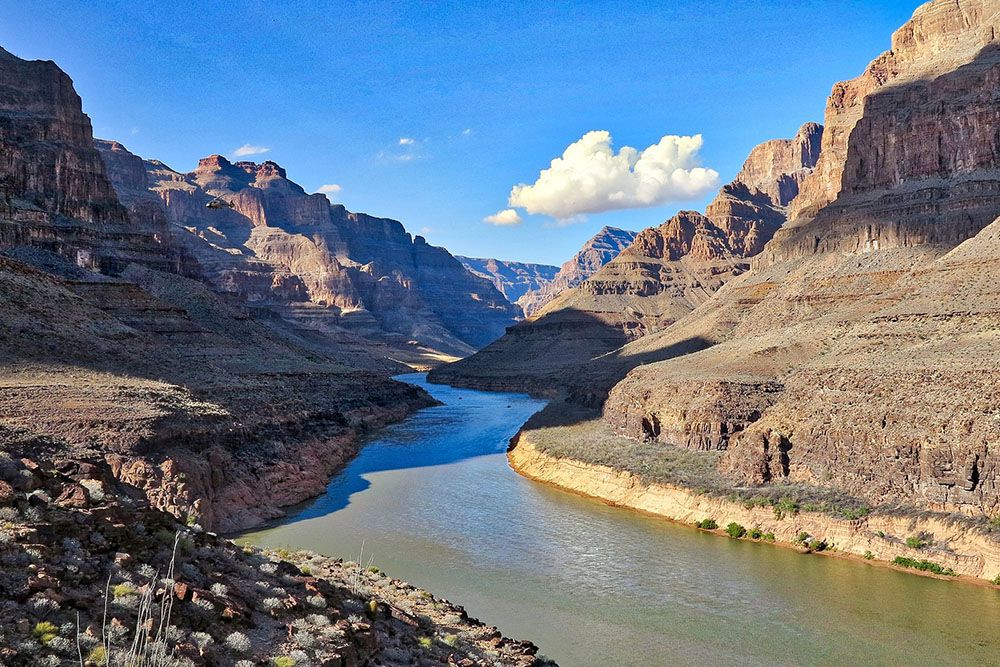
What you want to know to plan your visit to the Grand Canyon
The visitor centre at the South Rim (south rim) is easily accessible by car. From Interstate 40 from Williams, take two-lane AZ 64 to Grand Canyon Village. There is also a daily train to the park from Williams. Furthermore, you have shuttles that can take you from, say, Flagstaff to the park.
The visitor centre at the North Rim (Grand Canyon Lodge) is best reached by private transport (rental car or motorhome (no longer than 22 feet!)). From US 89A (not AZ 89A at Flagstaff !), take the two-lane AZ 67 (closed from mid-October to mid-May) south.
If you want to go from the South Rim to the North Rim or vice versa, take into account a travel time of about five hours by car. This is because you have to make a complete detour.
For pedestrians and cyclists, admission is $20 per person. If you come by private transport, you pay $35, regardless of the number of passengers. The entrance ticket is valid for seven days. You can enter and exit the park as many times as you want within those days.
Apart from hiking, you can use the free shuttles at the South Rim. These drive past the main viewpoints between Bright Angel Lodge in the west and Yaki Point in the east. By the way, you should leave your own car at one of the many car parks near the visitor centre or hotel. Another transport option is the rental bike.
At the North Rim, for longer distances, it is best to get around by car or motorhome. This applies, for example, to the Scenic Drive past viewpoints like Cape Royal and Point Imperial. There is a (free) shuttle service but it only runs a few times a day. Fortunately, most attractions on the North Rim are a short walk from the visitor centre.
The national park itself and the differences in altitude within the park are such that you have several mini-climates. At the North Rim, it is slightly colder and wetter than at the South Rim. At the Colorado River, in particular, it is much warmer than at the top of both the South and North Rim.
In general, the best seasons to visit the Canyon are spring and autumn. This is especially true for hikers. In summer, it can be very hot at the South Rim, but even (too) hot by river. Here, temperatures well into the 40s are not uncommon. Summer is a great season for the North Rim or to enjoy the waterfalls at Havasu, though. The North Rim is closed from mid-October to mid-May. The South Rim remains open. It is chilly but sunny then. And since there are few tourists, winter is a great season to admire the Grand Canyon from the South Rim.
At the South Rim you have plenty of restaurants or other places where you can get, for example, sandwiches. At the North Rim, the choice is significantly less, but in the immediate vicinity of the visitor centre you can get a good meal. Expect slightly higher prices for a meal than outside the parks. We found the quality of the food to be excellent. Click here for a list of restaurants in the national park.
There are several hotels, lodges and (affordable) campsites both inside and outside the park on both the North Rim and South Rim. The generally pricey but excellent accommodation near the Canyon fills up early. For this reason, many visitors choose to spend the night outside the park. This can be done in Tusayan, Williams and Flagstaff, among others.
The park is home to potentially dangerous predators such as the California condor, coyote, red lynx and cougar. Furthermore, in the west of the park lives the Grand Canyon rattlesnake. The snake will avoid any contact with humans by itself as much as possible. Visitors to the park generally have very little to fear from these animals. Indeed, the most dangerous animal in the Grand Canyon is the squirrel. Because not everyone seems to understand that you shouldn't feed these "cute" animals, they still sometimes want to bite if you bring them over.
You may also be interested in
- Hiking fun in Joshua Tree National Park
- Cycling and hiking in Yosemite National Park
- City trip to Los Angeles
- City trip to San Diego
- City trip to San Francisco

